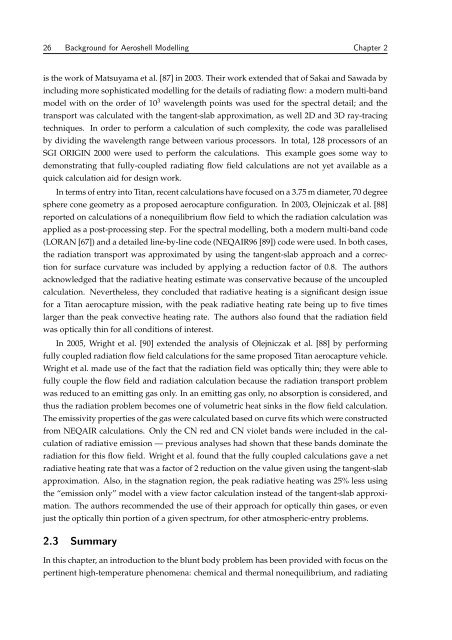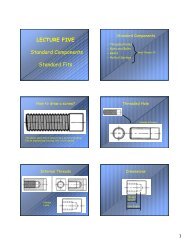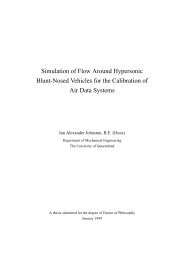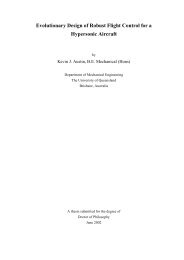Rowan-Gollan-PhD-Thesis - Mechanical Engineering - University of ...
Rowan-Gollan-PhD-Thesis - Mechanical Engineering - University of ...
Rowan-Gollan-PhD-Thesis - Mechanical Engineering - University of ...
Create successful ePaper yourself
Turn your PDF publications into a flip-book with our unique Google optimized e-Paper software.
26 Background for Aeroshell Modelling Chapter 2<br />
is the work <strong>of</strong> Matsuyama et al. [87] in 2003. Their work extended that <strong>of</strong> Sakai and Sawada by<br />
including more sophisticated modelling for the details <strong>of</strong> radiating flow: a modern multi-band<br />
model with on the order <strong>of</strong> 10 3 wavelength points was used for the spectral detail; and the<br />
transport was calculated with the tangent-slab approximation, as well 2D and 3D ray-tracing<br />
techniques. In order to perform a calculation <strong>of</strong> such complexity, the code was parallelised<br />
by dividing the wavelength range between various processors. In total, 128 processors <strong>of</strong> an<br />
SGI ORIGIN 2000 were used to perform the calculations. This example goes some way to<br />
demonstrating that fully-coupled radiating flow field calculations are not yet available as a<br />
quick calculation aid for design work.<br />
In terms <strong>of</strong> entry into Titan, recent calculations have focused on a 3.75 m diameter, 70 degree<br />
sphere cone geometry as a proposed aerocapture configuration. In 2003, Olejniczak et al. [88]<br />
reported on calculations <strong>of</strong> a nonequilibrium flow field to which the radiation calculation was<br />
applied as a post-processing step. For the spectral modelling, both a modern multi-band code<br />
(LORAN [67]) and a detailed line-by-line code (NEQAIR96 [89]) code were used. In both cases,<br />
the radiation transport was approximated by using the tangent-slab approach and a correc-<br />
tion for surface curvature was included by applying a reduction factor <strong>of</strong> 0.8. The authors<br />
acknowledged that the radiative heating estimate was conservative because <strong>of</strong> the uncoupled<br />
calculation. Nevertheless, they concluded that radiative heating is a significant design issue<br />
for a Titan aerocapture mission, with the peak radiative heating rate being up to five times<br />
larger than the peak convective heating rate. The authors also found that the radiation field<br />
was optically thin for all conditions <strong>of</strong> interest.<br />
In 2005, Wright et al. [90] extended the analysis <strong>of</strong> Olejniczak et al. [88] by performing<br />
fully coupled radiation flow field calculations for the same proposed Titan aerocapture vehicle.<br />
Wright et al. made use <strong>of</strong> the fact that the radiation field was optically thin; they were able to<br />
fully couple the flow field and radiation calculation because the radiation transport problem<br />
was reduced to an emitting gas only. In an emitting gas only, no absorption is considered, and<br />
thus the radiation problem becomes one <strong>of</strong> volumetric heat sinks in the flow field calculation.<br />
The emissivity properties <strong>of</strong> the gas were calculated based on curve fits which were constructed<br />
from NEQAIR calculations. Only the CN red and CN violet bands were included in the cal-<br />
culation <strong>of</strong> radiative emission — previous analyses had shown that these bands dominate the<br />
radiation for this flow field. Wright et al. found that the fully coupled calculations gave a net<br />
radiative heating rate that was a factor <strong>of</strong> 2 reduction on the value given using the tangent-slab<br />
approximation. Also, in the stagnation region, the peak radiative heating was 25% less using<br />
the “emission only” model with a view factor calculation instead <strong>of</strong> the tangent-slab approxi-<br />
mation. The authors recommended the use <strong>of</strong> their approach for optically thin gases, or even<br />
just the optically thin portion <strong>of</strong> a given spectrum, for other atmospheric-entry problems.<br />
2.3 Summary<br />
In this chapter, an introduction to the blunt body problem has been provided with focus on the<br />
pertinent high-temperature phenomena: chemical and thermal nonequilibrium, and radiating







